Calendula, also known as pot marigold, is a popular flowering plant grown for it's beneficial properties. This easy to grow herb has been grown throughout the ages for both culinary and medicinal purposes. Learn how to grow calendula, and enjoy this bright cheerful flower for all the benefits that it has to offer.

I grew lots of calendula this season, and was thrilled with the productivity of the plants.
Once the plants began to bloom, they continued to produce regularly throughout the entire growing season, and were still blooming well into the fall.
I grew the calendula for culinary use, as well as for using the flowers to make herbal products, made from soothing calendula oil infusions.
The flowers were harvested from the garden throughout the summer months, and were used in both fresh and dried forms.
The blooms were used to make colorful salads and sweet calendula tea, as well as infused calendula oil, calendula salve, and a nourishing lip balm.

What Is Calendula?
Calendula belongs to the daisy family, or Family Asteraceae. The plants belong to the Calendula Genus, which include approximately 25 different species.
The various species of calendula include both annual and perennial cultivars.
One of the most popular species to grow is Calendula officionalis, which is a tender perennial most often grown as an annual in colder climates.
The plants produce loads of seeds, which can be collected throughout the growing season, and then replanted the following year.

In tropical climates Calendula officionalis may over winter, although the plants often do not tolerate the hot summers in these very warm climates.
Calendula prefers the cooler weather of spring and fall, and often grows better in these seasons.
The use of calendula is steeped in history, having been used in ancient times in rituals and ceremonies. Often used as a ceremonial decoration, the flowers were braided into flower crowns and garlands for participants to wear.
Pot marigold is one of the common names for calendula, and is associated with the culinary use of the plant, which has often been used in soups and stews.
Mary's gold is another common name of calendula, and refers to the flower's use in ancient Christian events.
Both "Mary's gold" and "marigold", and other similar versions, were named for the Virgin Mary.
Now let's look at the parts of the calendula plant.

Calendula Flowers
- The flowers of calendula have a daisy-like shape, with the outer ray petals encircling the inner disc florets of the flower.
- The blooms can be single or double flowers, and range in size and shape depending on the species and variety.
- Most often found in shades of yellow and orange, calendula flowers stand out in the garden with their bright coloring. The flowers can also be multi-tone, with different shades on the top and the bottom of the blooms.
- Flower buds form throughout the growing season, and you will often find young buds along with fully opened blooms on the same plant.
- Once each flower is spent, the spent bloom quickly begins to form seeds if pollinated.
- At this point you will find new buds, blooming flowers, spent flowers, and seed pods in various stages of development all within the same flowering calendula plant.
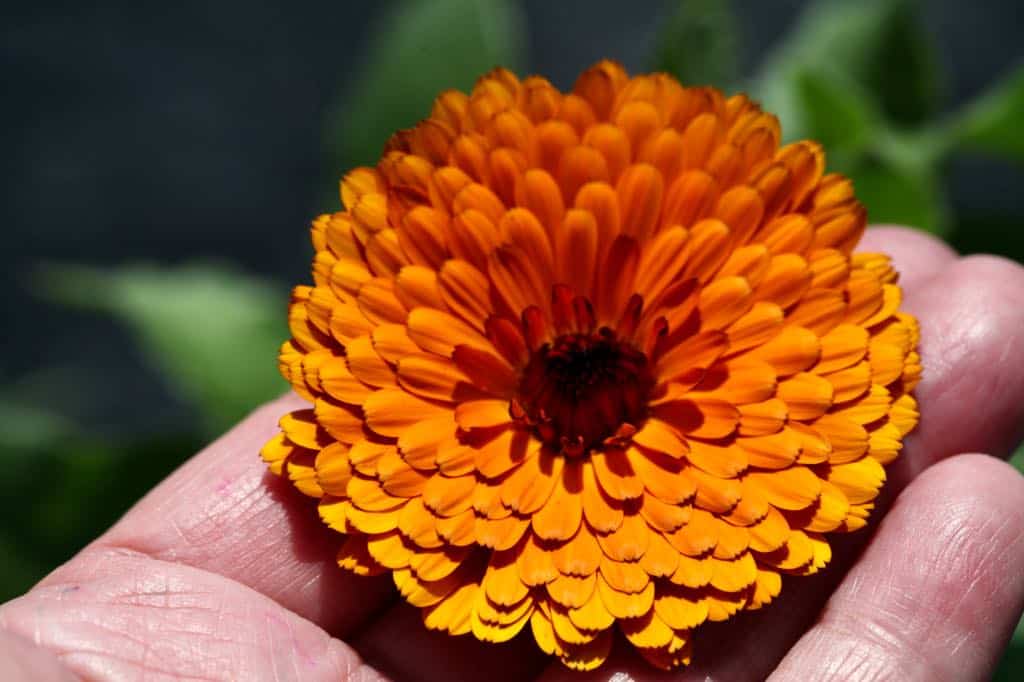
The Calendula Leaves
- The leaves of calendula are a medium green, and oblong, with a mostly smooth outer edge. The leaves are arranged spirally along the stems of the plant.
- Each leaf is covered with very tiny hairs which are visible on close inspection.
- When calendula seedlings are first planted, the new plants take on a mounded shape, consisting of leaves.

Calendula Stems
- Multiple calendula stems grow from the mounded leaves at the base of the plant.
- Along each stem, side branches will form, containing leaves and a terminal flower bud. The branching and flowering adds to the height and width of the plant.
- Plant height is 24 inches when grown in ideal conditions.
- As each stem produces multiple branches, new flowers will form, and the plant will continue to bloom throughout the growing season.
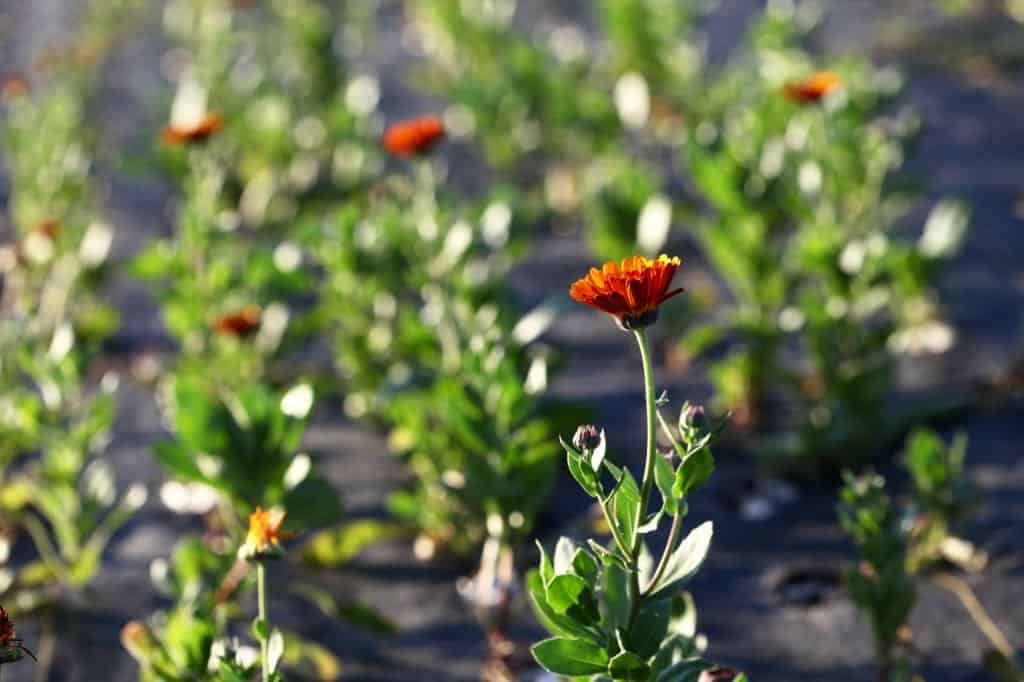
The Calendula Seeds
- The seeds of calendula are formed once the flower is pollinated.
- Unlike many other flowers in the garden, which form seeds at the very end of the growing season, calendula produces seeds all season long.
- Seeds are formed on the outside of the fruit, called cypselas, and are not enclosed. Once the seed pod matures, the seeds readily fall away from the pod back into the garden.


- The seeds have an unusual shape and are unique in appearance. They are found in shades of tan and brown, and are often curled into the shape of a "C".
- Along the back surface of each seed there are small bumps or spines. The overall look of calendula seeds reminds me of tiny dried sea creatures or grubs.
- Seeds vary in size, and can be 0.5 cm to 0.75 cm in length.

How To Grow Calendula
Calendula is very easy to grow from seed.
In colder climates the flower seeds are best grown indoors in late winter or early spring, to give them a head start on the growing season. Start the seeds six to eight weeks before the last spring frost.
I found that it took approximately 3 months for the plants to grow from seed to full bloom.
In warmer climates the seeds can be directly sown into the garden in the fall.
Seeds can also be directly sown in spring, when the garden soil warms up.

Let's look at the different methods for planting.
Grow From Seed Indoors
- To grow calendula from seed indoors, you will need containers filled with a soilless potting mix.
- I like to use seedling cell trays for planting, for ease of use and easy transplanting.
- Fill the containers with the soilless mix.
- Make small holes in the centre of each cell, approximately ¼ inch deep.
- Sow seeds by dropping a seed inside each planting hole.
- Cover the calendula seeds with more soil, or vermiculite. The seeds require darkness for germination.
- Bottom water the cell trays, and place on a heat mat to aide in germination. A warm soil temperature gives best germination results.
- Make sure to keep the soil moist during germination, and do not allow it to dry out.
- Calendula seeds generally germinate within one to two weeks.
- Once 60% of the seeds have germinated, place the cell trays under grow lights, until the seedlings are ready to be hardened off in spring, and planted into the garden.

Direct Sow Into The Garden
- Calendula can be sown directly into the garden in fall in warmer zones with mild winters.
- The seeds can also be grown in cooler zones in spring, after the last frost date.
- In cooler growing zones this means a later planting date, and can delay the blooming of the plants to a later date, rather than an earlier one, if they were started from seed indoors.
- You can also succession plant the seeds to extend blooming time. From my experience however, the initial plantings continued to bloom right into mid November, in our zone 5b garden.
- Direct sow calendula seeds into a weed free, prepared garden bed in a sunny location.
- Plant the seeds six inches apart and ¼ inch deep, and then cover the seeds with soil.
- Water the seeds in after planting.
- The new plants will grow in spring, and will be naturally hardened off, since they will be growing outside already.

Transplanting Calendula Seedlings
- If you have started calendula seeds indoors, the seedlings will need to be transplanted into the garden when the timing is right for your individual gardening zone.
- Transplant the young plants that have been grown indoors into the garden after hardening them off, and after the risk of frost has passed.
- Know the last frost date for your usda hardiness zone, to guide you on potential transplanting dates for the calendula seedlings.
- Space the plants at least 6 inches apart to allow for growth and good air circulation.
- When the plants are approximately 8 inches high, pinch back the flower buds on the main stems to help to promote branching, and bushy growth of the plants.
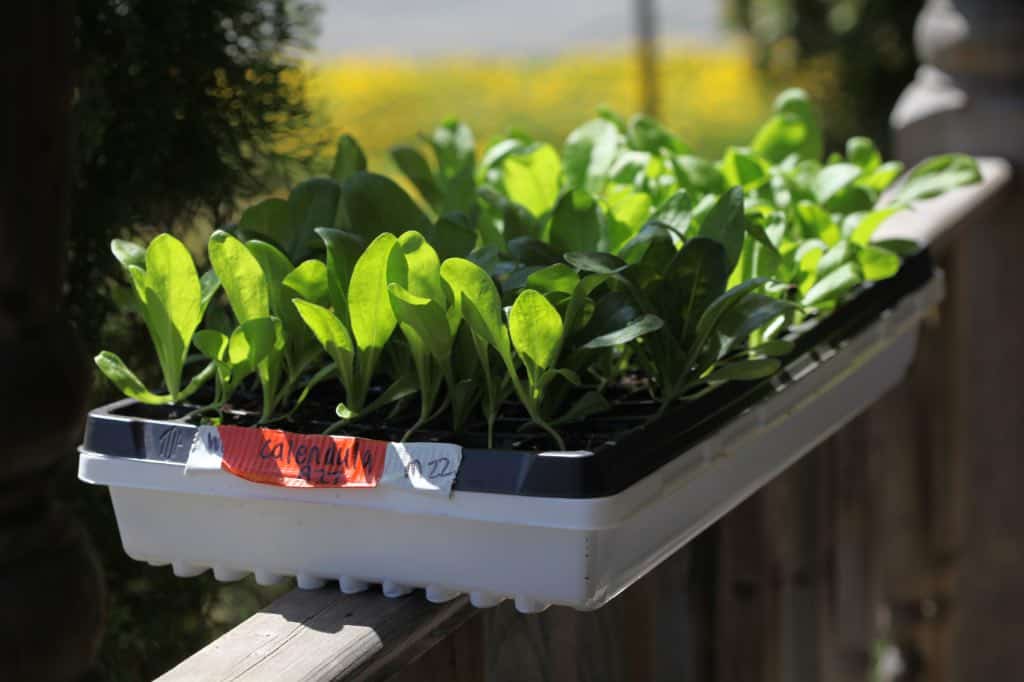
Calendula Care
Calendula will flourish if grown in the right place and given the right care.
They are low maintenance plants that are easy to grow, and will bloom optimally if provided with these ideal growing conditions.

Growing Zone
- When grown as an annual, calendula will grow in most growing zones. The individual growing zone however, is a consideration for where and when to plant.
- Grows well in usda hardiness zones zones 2 to 10.
Light Requirements
- Plant calendula in a full sun location for best blooming. The plant will also tolerate a partial shade or light shade location, especially if planted in a very warm growing zone.
- Calendula may wither in the hot sun in a tropical climate, so it's best to provide a location with some mid afternoon shade in warmer growing zones.
- Plants that have faded mid summer may bounce back in fall with another flush of blooms.

Soil Requirements
- Calendula is tolerant of most soil conditions, however does very well in well drained fertile soil with lots of organic matter.
- This plant prefers a ph of 5.5 to 7 for best blooming.
Moisture Requirements
- Calendula will grow well with just the moisture from the outdoor elements.
- During drought conditions however, make sure to provide some supplemental watering.
- The plants are susceptible to powdery mildew in moist environments, especially if grown closely together.

Deadheading And Pruning
- Whenever a plant begins to form seed, much of the plant's energy is directed into seed production. This can result in a decrease in blooming.
- Since calendula starts seed formation very early in the season, it is essentially forming seeds all season long.
- Consider deadheading some seed heads to divert the plant's energy back into blooming.
- Make sure to save some of the mature seeds for planting out next season.
- If calendula has stalled in it's growth mid summer, due to high heat, give the plant a trim, and it will likely rebound when the cool temperatures of late summer and fall return.

Harvesting And Preparing Calendula
Once calendula starts to bloom in the garden, it continues to grow throughout the entire season.
Harvesting The Flowers
- The flowers can be harvested on a regular basis, and used in both their fresh and dried forms.
- It's important to catch the flowers in their prime when harvesting, as they will quickly wither once in full bloom, and begin to form seeds.
- Harvest on a dry day, and after the morning dew has evaporated from the plants.
- If harvesting for fresh culinary use or for drying the flowers, harvest only the fresh newly bloomed flower heads from the plants.
- With a sharp clean pair of scissors or snips, cut the flower head just under the bloom, removing it from the stem.
- If harvesting for ornamental use, cut the stems off at the base of the stem.
- If you plan to dry the flower heads, it's important to prepare them for drying shortly after harvest, otherwise the flowers tend to wilt fairly quickly.
- Likewise, if you plan to use them in the fresh state, use the flower heads shortly after picking.
- If you are unable to process the blooms within an hour after harvest, it is best to harvest full stems, and place them into water, until you are ready to use them or process them.

Preparing The Fresh Flowers
- To use the flowers in the fresh state, first wash the flowers to remove any dirt, bugs, or garden debris.
- Dry the flowers on a piece of paper towel or on a clean dish towel.
- Process the fresh blooms by pulling the petals from the flowers. The bright colored petals can then be used in your intended dishes or drinks.

Drying The Flowers
- Drying the harvested calendula flowers will help to preserve them for later use.
- This will help you to stay on top of the bloom production, and take advantage of the abundance of harvested blooms.
- Dried calendula flowers are best to use if you are making calendula oil, as this eliminates the moisture from the flowers, and helps to prevent molding.
- The flowers can be air dried, dried in the oven at a low temperature, or dried in a food dehydrator.

How To Use Calendula
Calendula has many different uses, and can be used for it's benefits as a live plant in the garden, or as harvested flowers in both the fresh and dried forms.
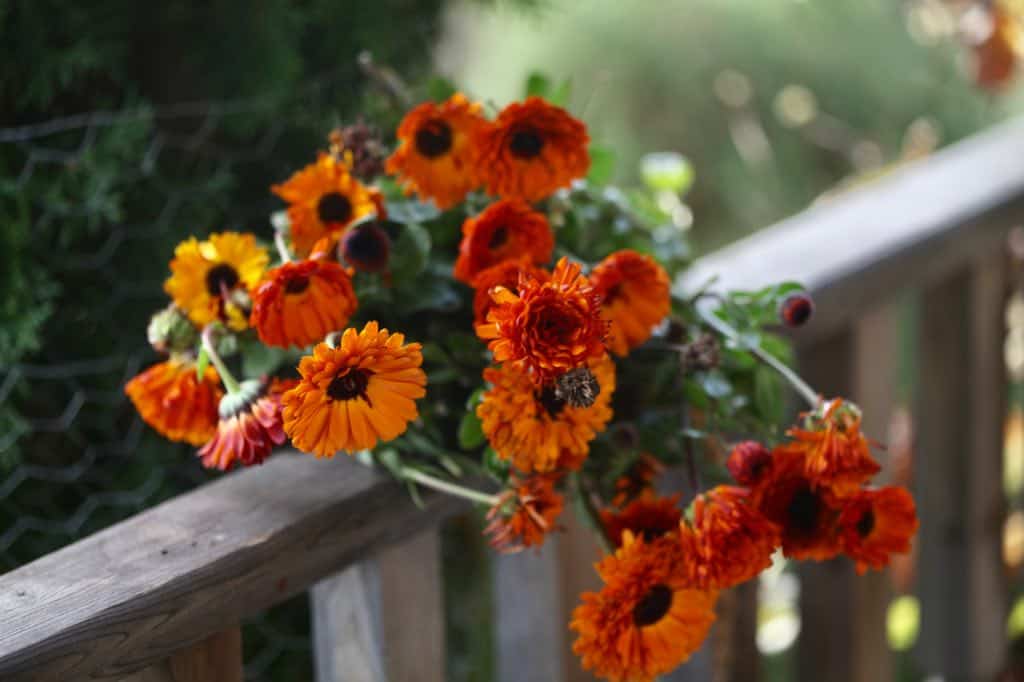
Use In The Garden
Calendula attracts pollinators and beneficial insects to the garden, including pirate bugs and parasitic wasps.
It also helps to deter unwanted garden pests, such as tomato hornworms and nematodes.
Attractive to pollinators in the garden, calendula is a great source of nectar throughout the growing season.
Calendula is a great companion plant, since it draws the beneficial insects and repels the pests. Grow with tomatoes, carrots, cucumbers and asparagus, as well as many other companions in the vegetable and herb gardens.
Calendula can also be used as an ornamental plant. The blooms make colorful cut flowers, although the flowers are not long lasting in the vase.
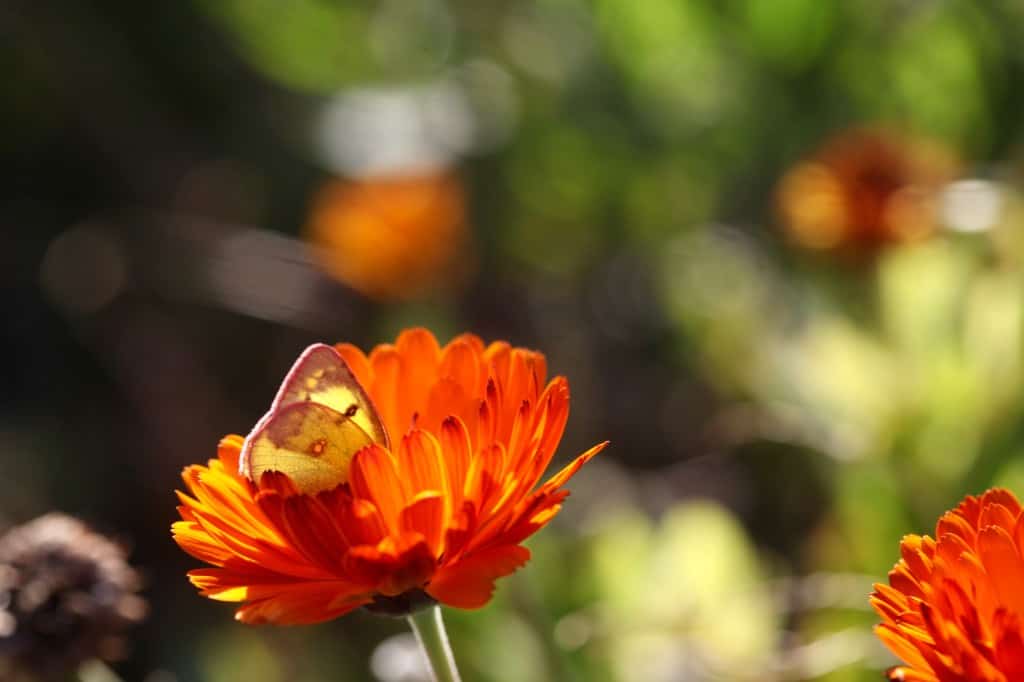
Culinary Use
Both fresh and dried calendula flowers have culinary use.
Calendula tea can be made with freshly picked calendula petals, as well as with dried petals which have been preserved and stored.
The colourful petals can be used to garnish all types of salads, pastas, and any other dish where the bright petals would help to create a finishing touch.
Edible calendula flowers can also be used to decorate baking.
Add the bright orange and yellow petals to edible flower cookies, edible flower ice cubes, and any other baking creations to make a colourful impression.
You can also create edible candied flowers with larger calendula petals, and use them to decorate your cakes and cookies.

Herbal Use
Three species of calendula, including calendula officinalis, have been studied pharmacologically to investigate their medicinal properties.
C. officinalis has been reported to exhibit antibacterial, antiviral, anti-inflammatory and antioxidant properties.
You can read more about the phytochemistry of calendula in this article from the National Library Of Medicine and Pubmed Central.
The beneficial compounds found in the base of the calendula officinalis flower head can be extracted from the flowers via infusion, and by soaking in an oil, such as organic almond or olive oil.
The calendula infused oil can then be used to make products that are beneficial to the skin, such as soothing calendula salves, lip balms, tinctures and ointments.

Use As A Dye
Calendula flowers can also be harvested to make a homemade calendula dye.
The flowers contain a bright dye which can be extracted from the blooms and used to dye textiles.
Colors of the dyes include different shades of yellow, orange, and brown, depending on the variety of calendula used.
The dye can be used to dye wools, silk, and other textiles made with natural fibres.

Conclusion
Calendula is a tender perennial which is grown as an annual herb in colder climates.
The edible flowers have great flower production, blooming from mid summer onwards and well into fall.
Calendula plants are perfect flowers for the herb garden, and are used for their medicinal and herbal properties.
Calendula is also a great companion plant for the vegetable garden and flower garden, attracting pollinators and beneficial insects, and repelling insect pests.
The blooms are valued for their culinary use, and the bright yellow and orange flowers make a colourful garnish for many dishes in the kitchen.
Consider growing calendula in your garden, to enjoy all the benefits that it has to offer.
Then make sure to harvest the calendula seeds at the end of the season, to have an unending supply of these wonderful plants, year after year.

Have you had an opportunity to grow calendula? Be sure to leave a comment below to share your experience!
Other Posts You May Like:
PIN IT FOR LATER!










Leave a Reply